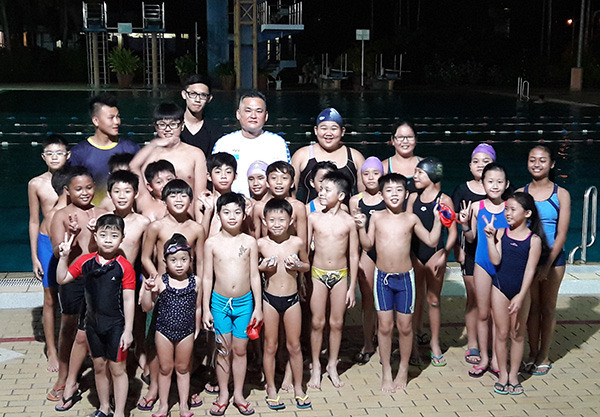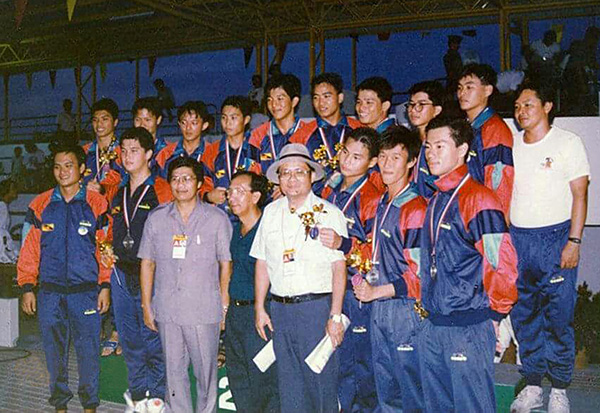
Voon (in white shirt) with his swimming coaches and young swimmers at the Power Aquatic Swimming Club.
SARAWAK used to be a water polo powerhouse in Malaysia, winning the National Open Championships 16 times in a row (1982 to 1998).
It was a long reign as champions and water polo even eclipsed the main event of swimming as an elite sport in the state at the time.
However, after 16 years at the top, the sport of water polo in Sarawak began to lose its shine and dominance. The last time the state team won the gold medal was at the 1990 Sukma, hosted by Sarawak.
Following the economic crisis in the late 1990’s, water polo slumped into the doldrums. Thereafter, Sarawak did not take part in any more competitions.
It took more than 15 years for the sport to make a much-awaited comeback in the state with first the major tournament — Sarawak 59th MILO-PRAM Malaysia Water Polo Championships — held at Pandelela Rinong State Aquatics Centre, Petra Jaya, recently.
A number of reasons were cited for the period of stagnation after 1999, foremost of which being the lack of support from the state government, parents and the public. As a result, the sport plunged to its lowest ebb — and has since been slow to recover.
Despite the setback, national water polo coach Voon Yong Hui is optimistic there is a future yet for the sport in the state.
According to him, swimming talents abound in the outland of Sarawak and they are waiting to be discovered.
“We need to spot these gems, polish them and give them a chance to shine,” he stressed.
Voon, a former Sarawak state waterpolo player, said potential in aquatics could be tapped in the many villages, inland or coastal, adding that these latent talents could be nurtured and groomed to become state water polo players and swimmers.
However, he pointed out, in a more subdued tone, that the glaring lack — or even absence — of swimming pools in especially the rural areas was hindering the discovery of hidden talents.
He hoped the Youth, Sports, and Solidarity Ministry would look into ways of giving rural kids the opportunities to develop their swimming potential in a systematic manner.
He also noted many parents had not been very supportive probably because of the stories they heard about water polo being a rough contact sport where serious injuries were common.
Although water polo is a demanding sport, Voon, who is preparing the national team for the SEA Games next year, said it was not as dangerous as perceived.
“Yes,” he conceded, “there may be some injuries like scratches or bruises. But if players wear proper gear, they will be fairly safe.”
“For example, wearing a polo cap protects the ears and the head, and a mouth guard protects the mouth. I would say water polo is a fairly a low-risk sport. In fact, it’s an awesome sport,” said Voon, who played for the national team from 1985 to 1987, was a national coach from 1985 to 1995 and also a former national team manager.
In 2012, he expressed optimism the sport could be back brought to its glory days of the 1980’s and 1990’s.
In 2014, he teamed up with two water polo enthusiasts — Chin Khoon Siang, a former state player, and Heath Cahalan, an Australian, then teaching at a private school here — to revive the sport.
Chin was the state coach in the early 1980’s before Voon took over and held the position until the early 1990’s.
Cahalan played for Wagga Wagga in Australia for seven years and toured New South Wales for competitions.
But sadly, despite their efforts, they could not even get a water polo class going as they were unable to find a proper venue and enrol enough students.
One problem was the lack of good swimmers whom they could get to play water polo. It is essential to master all the swimming strokes before starting to play.
Compounding the problem was the lukewarm response from swimming associations due to fears of losing their swimmers to water polo.
As for the present sluggish development of water polo, Voon opined it was due the lack of support from the state government.
“It could be that the sport is too expensive to fund since water polo is a team and not an individual sport.”
He believed Sarawak would be able to produce more Pandelelas in the future because diving is fully supported by the state government.
“I can confidently say this for diving but not water polo.”
Voon said to be good in any sport, not only was systematic training necessary but also plenty of competitions and tournaments for the athletes to improve and keep track of their performances.
But there had not been many competitions for swimming in the state, let alone water polo, he observed.
A life-saving skill
On the ability to swim, Voon said it obviously ensured more safety for anyone, especially children, who liked having fun in the water.
During the World Conference on Drowning Prevention 2015, hosted by the Life Saving Society Malaysia (LSSM), it was revealed that on average, between 650 and 700 drowning cases were reported annually over the past 10 years in the country — and drowning incidents are not decreasing.
It was also revealed there were 370,000 drowning cases worldwide and the World Health Organisation (WHO) recognised the figure had reached epidemic proportions, vastly outnumbering the death tolls of some of the most dangerous diseases such as Ebola.
Voon said young children were naturally attracted to water and many would jump into a pool to play without any thought of their safety.
He noted that the whole length of Sarawak was adjacent to the sea and there were also many beaches, rivers, lakes, streams and drains — plus almost all the holiday resorts had swimming pools.
“There is, thus, always a risk of drowning unless children are taught basic water survival skills.”
He confessed to getting emotionally devastated whenever he heard of drowning cases, saying these would not have happened if one knew the technique of keeping one’s nose above the water until help arrived.
He strongly felt schools, from primary level up, should incorporate swimming as one of their extra-curricular activities just like in Singapore.
He said it would be good if swimming pools could be built in the rural areas as well to teach children there proper swimming skills.
“With adequate facilities statewide, there will also opportunities for the young to take up swimming and train to become state swimmers. Who knows, we may see a new of breed of state swimmers emerging from the rural areas.”

The champion Sarawak water polo team in 1990 Sukma in Kuching.
Dual role
Voon said another great thing about swimming was that it could be learnt both as a life-saving skill and as a sport.
“Whereas for other sports, no matter how strong one is at any of them, one may not be able to save a drowning person. And remember, once you already know how to swim, you will never forget how to swim — even until you’re old.”
There is a saying that “success is a journey and not a destination”.
Voon said if the state wanted to produce swimmers for international meets, talents must spotted and nurtured young, adding that “this calls for long-term development.”
According to him, some swimmers would pursue their goals to very the end while some may quit halfway.
“Everyone has his or her own weaknesses and strengths and each will have the best chance of reaching full potential if treated as individuals. It’s all about correct training, competition and recovery throughout a young athlete’s career, particularly in relation to the important growth and development years.
“If your long-term goal is to nurture your child into a top swimmer, it’s best to start him or her young. It takes at least 10 years for an athlete to reach a proficient level of competitiveness. Many swimmers around the world who started between the age of six and eight, qualified for their first Olympics on reaching their teens.”
Voon believed local schools did not have swimming pools because they were very expensive to build and maintain.
“Moreover, when it comes to organising swimming activities, a school, for example, has to hire a bus, pay for swimming coaches and get its own teachers to chaperon the students. All these could be deterring factors.”
Another minus for swimming is that it is considered as almost a luxury sport like golf — usually only for those who can afford it.
Voon said proper attire is needed for swimming — which could be costly to moderate income families.
“Swimmers need bathing suits, goggles, swim caps and additional accessories such as flip flops.”
He hoped the state government would try to make swimming accessible to the people, including providing qualified coaches.
After all, he pointed out, swimming was a life-saving skill and it made sense for as many people as possible to learn how to swim.
Unfounded fear
Voon attributed the difficulty in enrolling young children for swimming lessons to an unfounded fear on the part of parents for anything that has to do with water and children.
“Such parents seem over-worried about their children’s safety and always advise their kids to avoid places with water, otherwise they may drown.
“But then, how long can parents keep a constant watch on their kids? Once they have become teenagers, they are youthful, energetic, adventurous and likely to take risks. That’s why we sometimes hear of misadventures that result in drowning.
“In fact, for nervous parents who worry about such mishaps, that very fear of theirs should be the very reason they should let their kids learn how to swim. If a person falls into the water, it does make a great difference for the one who can swim and the one who cannot.”
He said one of his goals is to create a state team in water polo — which is why he has started the Power Aquatic Swimming Club, hoping it could attract more people into swimming, and from there to eventually gather enough swimmers to identify potential water polo players.

Christopher Tan and his family.
More standard facilities
A mother of two sons, Julie Tan, said she also felt government should try to give the sport of swimming more support, adding that facilities should be made easily available to primary school kids.
She suggested setting up a state pool offering free entrance or charging only a nominal fee.
“Right now, those who want to learn swimming need to meet expenses which not everyone can afford.”
Julie said she was fortunate she had the chance to learn swimming at very young age because she had a very kind tuition teacher who brought her for swimming lessons.
“The teacher believed every child deserves to learn swimming because it is an important life skill.”
And for that, she is thankful to the teacher — and, of course, her parents for trusting and allowing her to go with the teacher.
Julie continues to swim to keep fit while her sons are taking swimming classes at Power Aquatic Swimming Club at Stampark Waterpark for RM200 a month.
A parent from Kota Samarahan, Christopher Tan, who has two children —— son and a daughter — taking swimming lessons at Stampark Waterpark, said generally, low-income families could not afford the sport of swimming.
As facilities are not easily available, he considered swimming a luxury sport.
He said although Kota Samarahan has a swimming pool, it was not well maintained.
“Not only is there no proper coach, there are also no proper opening hours. That’s why I brought my children to Stampark Waterpark.”
He said he was prepared to sacrifice his time and effort sending his two children to the pool because he realised swimming is an important life skill.
He believed the swimming lessons would help his kids to be perseverant and disciplined. They could also exercise and make friends.
Tan noted there was an imbalance between the numbers of swimming pools and trained coaches and hoped the ministry concerned would look into it.
Meanwhile, a retired civil servant said he learned to swim in the river as a little boy living in a village.”
“There were crocodiles in the river and it was a miracle I was not eaten by one. A bunch of naked boys frolicking in the water must have been a tempting meal to the reptiles. But little boys like us were not afraid because back then, we never heard of anyone being eaten by crocodiles,” added 61-year-old pensioner Vincent Wang.
He recalled nearly drowning several times and has lost count of how many times he swallowed the murky river water while trying desperately to stay alive.
As a teenager, Wang once saved the life of his younger sister. They were crossing a bridge made of a single coconut trunk when she slipped and fell into a wide drain. He jumped in and pulled her out.
“If I couldn’t swim, my sister would certainly have been gone forever,” he said, adding that this was why nowadays, he always advised people to learn how to swim.
He hoped the rural areas would have proper swimming facilities so that kids there would not have to learn swimming like he did.
